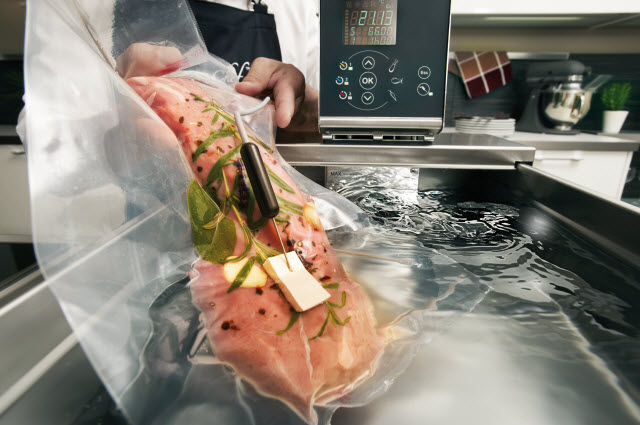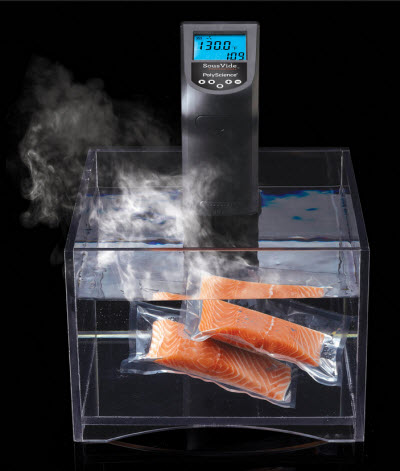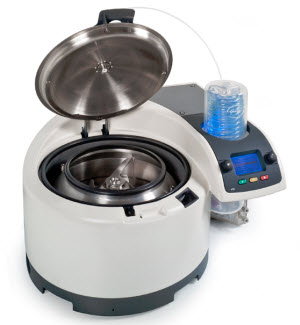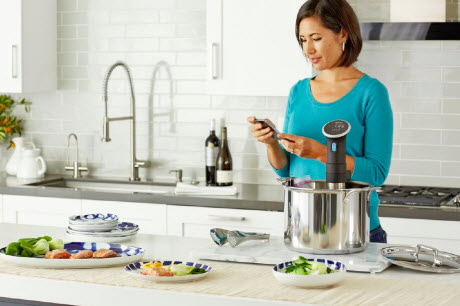 Julabo's core temperature sensor is just one of the products it makes specifically for sous-vide cooking as part of its fusionchef line of culinary products.Photo courtesy of Julabo
Julabo's core temperature sensor is just one of the products it makes specifically for sous-vide cooking as part of its fusionchef line of culinary products.Photo courtesy of Julabo
Things didn’t go so well when Jeff Wu first started cooking sous-vide with lab equipment. Sous-vide, French for “under vacuum,” involves vacuum-sealing food into a plastic bag and then cooking it over a long period at a low temperature in a water bath. And, while laboratory water baths can be used for this method, they do have their drawbacks as Wu, senior engineer at Anova (Stafford, TX), soon found out.
“The first circulator that I used to cook … was before we [Anova] started building circulators ourselves,” he said. “The pumps in the circulators are not designed to be touched by bags. So what happened was, I had the bag in the circulator and the circulator started smoking and set off the fire alarm in the building. I basically had a rain shower in the lab. That was one of the first experiences I had. I had lots of people ticked off at me for that.”
Another issue he ran into was being unable to take the unit apart quickly to clean it when the bags broke open. Those experiences led Wu to first modify the equipment, and then build his own unit specifically for culinary use, which was how Anova entered the culinary market.
“The Anova One, was a system that I essentially built for myself just with our machine shops,” he said. “It was a machine that was designed around the problems with using lab equipment to cook. Lab equipment really isn’t cooking equipment, not by a long shot.”
While using scientific equipment in kitchens isn’t new, particularly in Europe where sous-vide cooking was developed, lab equipment manufacturers creating separate culinary business units is a fairly recent trend.
Anova started its culinary unit about two years ago, focusing on instruments specifically for sous-vide cooking in the home, rather than high-end restaurants. Other water bath companies such as Julabo and PolyScience also have separate culinary divisions, with Julabo starting their fusionchef brand of culinary water baths about six years ago and PolyScience launching the first sous-vide immersion circulators in 2005.
Recipe and Video Resources: |
For Julabo and PolyScience, it was the culinary market that approached them.
Bruno Goussault, a French scientist, cook, and pioneer of the sous-vide method, used Julabo scientific water baths when he was first developing the technique in the 1970s.
“He used Julabo’s products because Julabo, founded in Germany in the Black Forest area, is very close to the French border, it’s about 20 miles,” explained Dirk Frese, director of sales and marketing at Julabo. “So that obviously was a natural pick for him to go for these units first, before Julabo was even aware. He was using them in this scientific cooking environment and from there developed the [sous-vide] process even further.”
PolyScience’s journey into the culinary world began when they got a call from Matthias Merges, chef de cuisine at Charlie Trotter’s restaurant in Chicago, Illinois.
“Fortunately our customer service person said she did not have experience with cooking applications but said that our president is an avid cook so perhaps he knows,” said PolyScience president Philip Preston, who has now won the Starchefs award for innovation three times. “I immediately began learning about the technique from the world’s best chefs and, seeing the opportunity, I began marketing culinary products.”
While Anova’s main focus is on products for the home, Julabo and PolyScience target high-end restaurants, though PolyScience does have a focus on the consumer market as well.
“We are more in the higher-end restaurants or schools for chefs,” Frese said. “That is usually where you find these instruments. We see ourselves more in the professional chef area as well as professional kitchens where there are a lot of people to be fed.”
However, the consumer market is growing, as shown by Anova’s success with the Anova One and PolyScience launching a line through Williams Sonoma in 2010 catering to consumers. PolyScience continued to develop lower-cost products, however, Preston added, “While today there are lower-priced models available, our objective has been to provide high-quality units that will give years of reliable service.”
A growing market
Getting into the culinary world has been a good decision for the water bath manufacturers so far.
“The growth rate between our lab business and the culinary, or fusionchef business, is really the same, up to the same percentage,” Frese said. “We see a lot of potential here, in North America specifically, because this was developed in France in the seventies so Europe has been exposed to that kind of technique much longer. In the U.S. and Canada, it’s pretty new. In Canada, we see people are better educated when it comes to sous-vide than in the U.S., so we have a big upside potential in the U.S.”
PolyScience and Anova have also seen quick growth.
Most Delicious Things Made with Their Products: - Jeff Wu: Brisket: “In Texas at least, cooking brisket is the hardest thing to do because it takes so much time and effort and it’s been reduced by a machine to be basically just two settings.”
- Dirk Frese: Portobello Mushrooms: “When you cook them in an open pan, you really reduce the mushroom and they shrink a lot, whereas when they come out of a sous-vide bag, the volume is different, it’s really moist and tasty.”
- Alison Wake: Strawberry sauce: “It’s a very intense flavor. That’s what the chefs really like about it [using the Genevac Rocket].”
- Philip Preston: Butter Poached Lobster by Thomas Keller of Per Se and The French Laundry: “It truly showcases the benefits of precise temperature cooking.”
|
“While our laboratory and industrial business has enjoyed excellent growth, our culinary division has grown extremely rapidly and represents 20 percent of our overall turnover,” Preston said of PolyScience’s culinary division. On July 1, 2014, culinary appliance company Breville entered into an agreement to acquire the global distribution rights for the current and future PolyScience culinary products in both the consumer and commercial channels, he added.
Wu said that for Anova, their culinary division is doing so well that he thinks it will soon account for most of their overall sales.
“When we first put out the Anova One two years ago, it just took off,” he said. “It was the first unit designed for home use and just general culinary use. The volume we do now for culinary, at our current growth rate, is going to outstrip our scientific business I think within this year. In two years, it’s going to dominate our entire operation. There’s a lot of growth in the area.”
Kitchen versus lab
To deal with the specific needs of chefs, and prevent problems such as the ones Wu experienced when starting to cook sous-vide, water baths designed for culinary use have several features which set them apart from lab models.
 PolyScience's water baths designed specifically for culinary use, such as the Sous Vide Professional CREATIVE Series, have a more rugged design and are more resistant to steam than water baths designed for the lab.Photo courtesy of PolyScience via flickr“The culinary products are exposed to very rough handling and often run at elevated temperatures 24/7,” Preston said. “This led us to a patented design that is quite rugged and resistant to prolonged exposure to steam. Additionally, as the technique moved to the consumer market, we had to drive the price point down. In 2005, these units cost $1,200 and, today, a home chef can buy a unit for $399.”
PolyScience's water baths designed specifically for culinary use, such as the Sous Vide Professional CREATIVE Series, have a more rugged design and are more resistant to steam than water baths designed for the lab.Photo courtesy of PolyScience via flickr“The culinary products are exposed to very rough handling and often run at elevated temperatures 24/7,” Preston said. “This led us to a patented design that is quite rugged and resistant to prolonged exposure to steam. Additionally, as the technique moved to the consumer market, we had to drive the price point down. In 2005, these units cost $1,200 and, today, a home chef can buy a unit for $399.”
Wu and Frese added that these culinary units are easier to clean and the pumps and heating components are protected so the bag doesn’t touch them and get damaged. The Anova unit can even go in the dishwasher for easier cleaning and the stainless steel in Julabo’s units makes them easier to disinfect, as preventing the growth of harmful bacteria is critical when cooking sous-vide.
“In the lab, you discard the water or whatever media is used and wipe it down and then [you] are done–you are not worried so much about bacteria on the surface of the stainless steel,” Frese explained. “In the food industry of course, that’s a major concern.”
Industrial or lab circulators have concerns kitchens don’t, such as being sealed for Class 3 solvents so they can run methanol and alcohols, and they must also have electronics that don’t spark, Wu said.
“All these things don’t matter for home use because you’re not going to be running methanol in your house,” he said. “That’s never going to happen… but what you do see in a house are oily fumes from cooking.”
That means a different venting system in culinary units. “The industrial system venting is designed to keep the fumes out of the unit but with the home system, you want to push the fumes onto a back grate so the oily stuff gets caught in the back,” Wu said.
Other equipment
Water baths aren’t the only type of lab equipment being used in kitchens. Top restaurants use freeze dryers, evaporators, and other gadgets normally used by scientists. And they aren’t just using them for sous-vide cooking.
For example, high-end restaurants are using SP Scientific’s Genevac Rocket evaporator, which works by boiling a solvent at a low temperature and reducing the vacuum. Like most of the other lab equipment manufacturers, SP got into the culinary market when they were approached by a chef–in their case, Heston Blumenthal of the Fat Duck restaurant in the UK.
 SP Scientific's Genevac Rocket centrifugal evaporator is being used in high-end restaurants to concentrate sauces or stocks for a more intense flavor.Photo courtesy of SP Scientific“He does lots of innovative culinary research and had been using rotatory evaporators, saw our centrifugal evaporation systems, and thought that they’d probably have an application within his cooking,” said Alison Wake, Genvac product and marketing manager at SP Scientific.
SP Scientific's Genevac Rocket centrifugal evaporator is being used in high-end restaurants to concentrate sauces or stocks for a more intense flavor.Photo courtesy of SP Scientific“He does lots of innovative culinary research and had been using rotatory evaporators, saw our centrifugal evaporation systems, and thought that they’d probably have an application within his cooking,” said Alison Wake, Genvac product and marketing manager at SP Scientific.
Since they were approached by Blumenthal, SP has added an accessory that allows Rocket users to run six 450 mL glass flasks at once and a bowl rotor that lets them concentrate up to five liters at once, giving more options to both lab and culinary users.
“There’s flexibility there for preparing individual portions in flasks or preparing a batch in a bowl,” Wake said, adding most kitchens tend to use the bowl rotor. “With the flask system, they can put different things in there and concentrate them at the same time.”
Though water baths for kitchen and lab use are different, the Rocket is the same for both applications. The system is geared towards analytical chemists who are looking for very volatile compounds but don’t want to evaporate those compounds, so they need gentle evaporation, Wake said.
“The same principles apply in the culinary application and that’s looking to concentrate flavors and aromas and they don’t want to lose the volatile compounds that result in those flavors and aromas,” Wake explained. “So using our gentle evaporation system, chefs are able to concentrate sauces and juices and that kind of thing, concentrate the flavor without losing it and the aromas. You’re not actually heating the product because you’re boiling at a low temperature.”
That process helps chefs create sauces with very intense flavors, which has landed the Rocket in about five high-end restaurants. For SP, the culinary market remains a niche part of their business, though the company is considering developing an evaporator specifically for culinary use.
“The interest is out there and we’re looking at it, but we’re not promising anything at the moment,” Wake said.
While Anova and Julabo are centered on sous-vide cooking, PolyScience does have several other products for various types of cooking such as the Anti-Griddle, a -30°F griddle surface for which Preston won the Food Network and Madrid Fusion awards.
“I also developed The Smoking Gun, a handheld food smoker that allows an infusion of smoke flavor to foods that could not be smoked in traditional methods,” added Preston, who has been a judge on “Iron Chef America” and presenter on “The Next Iron Chef.” “We have launched a line of vacuum sealers, an ultrasonic unit for flavor infusion and barrel aging, and a rotary vacuum evaporator for extracting aromatics and fractioning sauces.”
Moving forward
As for future plans, Wu said Anova has more devices coming out, along with a Wi-fi system, which fit the culinary branch’s focus on the connected home. Currently they have a Bluetooth-based system on their latest unit that connects to users’ smartphones, allowing them to cook with their phone. With the Wi-fi system, set to release mid-year, users will be able to cook from anywhere.
 Anova's latest sous-vide unit allows users to cook with their smartphone. Future plans will focus on the smart home.Photo courtesy of Anova“You could set your food up in the morning and from work you could say, ‘I want to cook this filet right now,’ or, ‘I want this ribeye to be the way I want it to be done when I get home.’ So, you just start your unit from your car [before you get on the road] or you could preheat your system before you come home,” Wu explained. “Our focus for the home is on making people’s lives easier, whereas our focus for the industrial areas was performance, performance, performance.”
Anova's latest sous-vide unit allows users to cook with their smartphone. Future plans will focus on the smart home.Photo courtesy of Anova“You could set your food up in the morning and from work you could say, ‘I want to cook this filet right now,’ or, ‘I want this ribeye to be the way I want it to be done when I get home.’ So, you just start your unit from your car [before you get on the road] or you could preheat your system before you come home,” Wu explained. “Our focus for the home is on making people’s lives easier, whereas our focus for the industrial areas was performance, performance, performance.”
For Julabo, the focus is on further developing the culinary market and familiarizing North American audiences with sous-vide cooking through both traditional and social media.
“We ask chefs to develop recipes with us and to distribute them to the users,” Frese said. “We see that the units are pretty well-developed, so we don’t see an immediate need to change there. It’s more about getting into the cooking schools in the U.S. to tell them that this technique should be widened in use.”
All of the major manufacturers who’ve branched out into the culinary field aim to make sous-vide more accessible.
“Sous-vide sounds rather intimidating and it is really a simple technique of cooking food at a precise temperature, rather than using high temperature and relying on precise timing,” Preston said. “For me, the best steak is cooked to 137 F and then marked on a grill. This allows a perfect result when the steak is cooked for one hour or two hours at 137 F. I will be releasing a book on the subject in the second quarter of 2015 filled with useful tips and recipes.”
Based on the amount of recipes and chef buy-in on these vendor’s websites, it looks like the culinary market will only continue to expand.
Things didn’t go so well when Jeff Wu first started cooking sous-vide with lab equipment. Sous-vide, French for “under vacuum,” involves vacuum-sealing food into a plastic bag and then cooking it over a long period at a low temperature in a water bath. And, while laboratory water baths can be used for this method, they do have their drawbacks as Wu, senior engineer at Anova (Stafford, TX), soon found out.
“The first circulator that I used to cook … was before we [Anova] started building circulators ourselves,” he said. “The pumps in the circulators are not designed to be touched by bags. So what happened was, I had the bag in the circulator and the circulator started smoking and set off the fire alarm in the building. I basically had a rain shower in the lab. That was one of the first experiences I had. I had lots of people ticked off at me for that.”
Another issue he ran into was being unable to take the unit apart quickly to clean it when the bags broke open. Those experiences led Wu to first modify the equipment, and then build his own unit specifically for culinary use, which was how Anova entered the culinary market.
“The Anova One, was a system that I essentially built for myself just with our machine shops,” he said. “It was a machine that was designed around the problems with using lab equipment to cook. Lab equipment really isn’t cooking equipment, not by a long shot.”
While using scientific equipment in kitchens isn’t new, particularly in Europe where sous-vide cooking was developed, lab equipment manufacturers creating separate culinary business units is a fairly recent trend.
Anova started its culinary unit about two years ago, focusing on instruments specifically for sous-vide cooking in the home, rather than high-end restaurants. Other water bath companies such as Julabo and PolyScience also have separate culinary divisions, with Julabo starting their fusionchef brand of culinary water baths about six years ago and PolyScience launching the first sous-vide immersion circulators in 2005.
Recipe and Video Resources: |
For Julabo and PolyScience, it was the culinary market that approached them.
Bruno Goussault, a French scientist, cook, and pioneer of the sous-vide method, used Julabo scientific water baths when he was first developing the technique in the 1970s.
“He used Julabo’s products because Julabo, founded in Germany in the Black Forest area, is very close to the French border, it’s about 20 miles,” explained Dirk Frese, director of sales and marketing at Julabo. “So that obviously was a natural pick for him to go for these units first, before Julabo was even aware. He was using them in this scientific cooking environment and from there developed the [sous-vide] process even further.”
PolyScience’s journey into the culinary world began when they got a call from Matthias Merges, chef de cuisine at Charlie Trotter’s restaurant in Chicago, Illinois.
To continue reading this article, sign up for FREE to

Membership is FREE and provides you with instant access to eNewsletters, digital publications, article archives, and more.



 Julabo's core temperature sensor is just one of the products it makes specifically for sous-vide cooking as part of its fusionchef line of culinary products.
Julabo's core temperature sensor is just one of the products it makes specifically for sous-vide cooking as part of its fusionchef line of culinary products.










